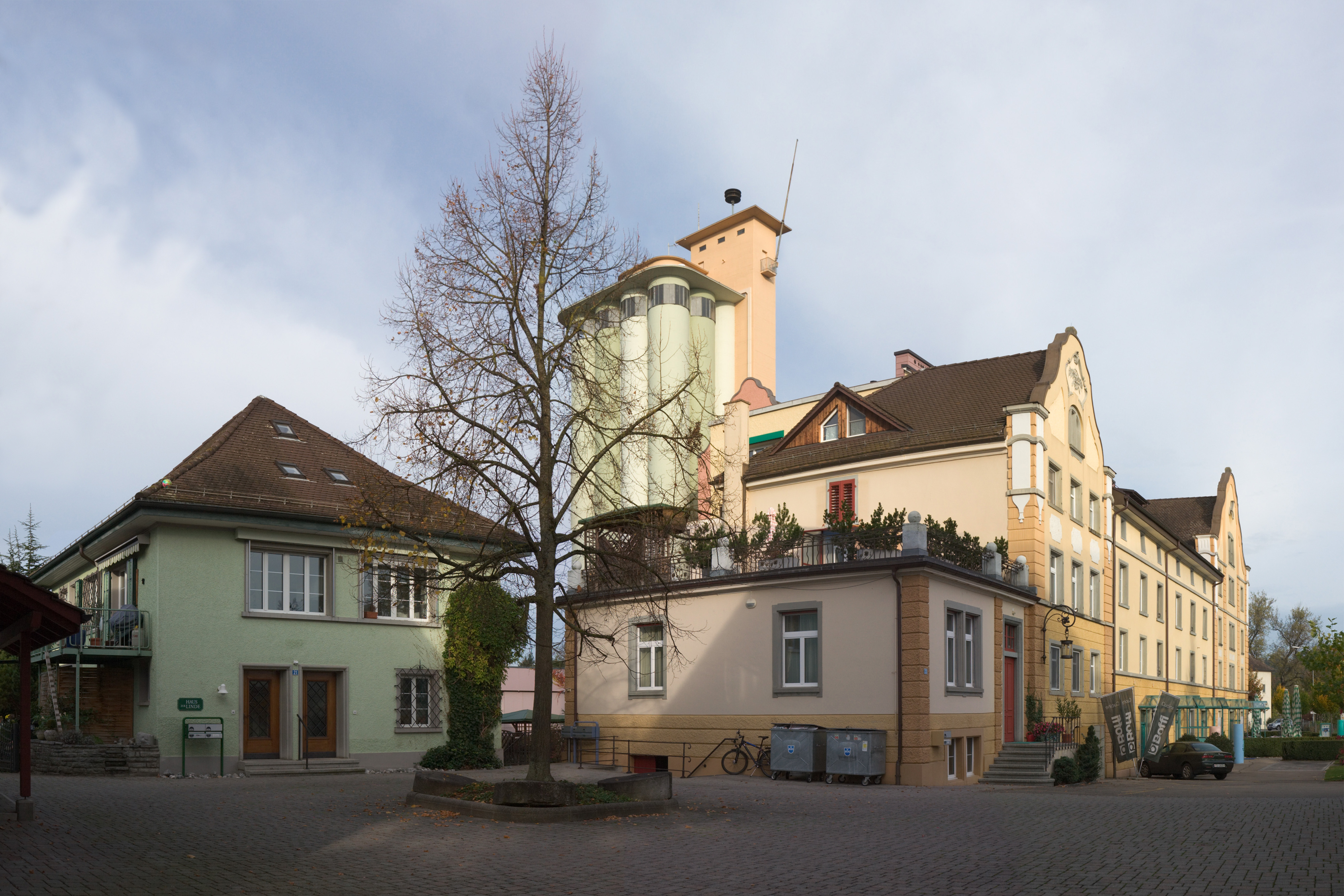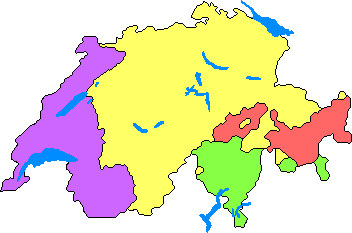|
Frauenfeld
Frauenfeld ( Alemannic: ''Frauefäld'') is the capital of the canton of Thurgau in Switzerland. The official language of Frauenfeld is (the Swiss variety of Standard) German, but the main spoken language is the local variant of the Alemannic Swiss German dialect. History Early history The earliest traces of human settlement are several La Tène era graves to the east of Langdorf. The Roman road from Oberwinterthur (''Vitudurum'') to Pfyn ran through what is now the ''Allmend'' in Frauenfeld. Two Roman villas were discovered in Thalbach and Oberkirch. The villa seems to have become the focal point of the later settlement of Oberkirch. On the ruins of the villa, an Early Middle Ages cemetery was built, and by the 9th century, the Oberkirch church was built. Perhaps as a result of royal donation in the 9th century, or more likely a donation in the 13th century, the area around Frauenfeld belonged to the ''Dinghof'' (a church- or monastery-owned manor farm) of ''Erching'' ... [...More Info...] [...Related Items...] OR: [Wikipedia] [Google] [Baidu] |
Matzingen
Matzingen (Swiss German: Matzinge) is a municipality in the district of Frauenfeld in the canton of Thurgau in Switzerland. History Matzingen is first mentioned in 779 as ''Mazcingas''. During the High Middle Ages, the Freiherr of Matzingen had the low court rights. Sonnenberg began to rule over the village in 1402 and remained over the village until 1798. In 894 Matzingen had a church, which belonged to Wängi. The right to appoint the priest was first held by the Abbey of St. Gall, until 1401, when the Commandry of Tobel took over this right. Matzingen became a separate parish in 1508 and converted to the new Reformed faith in 1529. For centuries farming, fruit production and viticulture (the latter operated until 1908) dominated the local economy. After 1850, livestock production and dairy farming were added to traditional agriculture. Between 1150 and 1996, Matzingen owned a mill. In 1863 a pottery plant opened. Followed, in 1866, by a spinning mill, which tr ... [...More Info...] [...Related Items...] OR: [Wikipedia] [Google] [Baidu] |
Felben-Wellhausen
Felben-Wellhausen is a municipality in the district of Frauenfeld in the canton of Thurgau in Switzerland. The municipality was created in 1983 by a merger of Felben and Wellhausen. History Roman era coins have been found in the municipality. The modern village of Felben is first mentioned in 1178 as ''Veluen''. In 1433 it was mentioned as ''Felwan''. In 1178 Alt St. Johann monastery in the Toggenburg region became the landlord of the village. From the Late Middle Ages until 1798, the courts for the village were held in the city of Frauenfeld. Prior to the Protestant Reformation Felben, which probably had a chapel starting in the 9th Century, belonged to the parish of Pfyn. By no later than 1569, Felben and Wellhausen formed a Reformed parish. The priest of the parish was appointed by the '' Herrschaft'' of Wellenberg and the city of Frauenfeld. The Catholics in Felben were part of the Catholic parish of Frauenfeld. Until the 19th Century most of the surrounding fields ... [...More Info...] [...Related Items...] OR: [Wikipedia] [Google] [Baidu] |
Thundorf, Thurgau
Thundorf (pronounced , in the local dialect or )Philipp Obrist/Andres Kristol, ''Thundorf TG (Frauenfeld)'' in: ''Dictionnaire toponymique des communes suisses – Lexikon der schweizerischen Gemeindenamen – Dizionario toponomastico dei comuni svizzeri (DTS, LSG)'', Centre de dialectologie, Université de Neuchâtel, Verlag Huber, Frauenfeld/Stuttgart/Wien 2005, and Éditions Payot, Lausanne 2005, , p. 873f. is a municipality in the district of Frauenfeld in the canton of Thurgau in Switzerland. The village of Thundorf lies on a plateau above Frauenfeld. In 1995, the communal territory was enlarged to the east, when Wetzikon and Lustdorf, the latter of which until then was autonomous, were joined to it. Coat of arms Blazon: ''Gules, a fess argent between three mullets of six points argent (2, 1).'' Etymology The earliest mention of Thundorf dates back to the year 888 (''Tuomsdorof/*tuomesdorf''). This place name is composed by the OHG anthroponym ''Duomo/*Tuomo'' an ... [...More Info...] [...Related Items...] OR: [Wikipedia] [Google] [Baidu] |
Uesslingen-Buch
Uesslingen-Buch is a municipality in the district of Frauenfeld in the canton of Thurgau in Switzerland. It was formed in 1995 from the union of the municipalities of Uesslingen and Buch bei Frauenfeld. Geography Uesslingen-Buch has an area, , of . Of this area, or 75.5% is used for agricultural purposes, while or 13.8% is forested. Of the rest of the land, or 7.8% is settled (buildings or roads), or 2.6% is either rivers or lakes and or 0.3% is unproductive land.Swiss Federal Statistical Office-Land Use Statistics 2009 data accessed 25 March 2010 Of the built up area, industrial buildings made up 3.2% of the total area while housing and buildings made up 0.0% and transportation infrastructure made up 0.1%. while parks, green belts and sports f ... [...More Info...] [...Related Items...] OR: [Wikipedia] [Google] [Baidu] |
Frauenfeld (district)
Frauenfeld District is one of the five districts of the canton of Thurgau, Switzerland. It has a population of (as of ). Its capital, and the capital of Thurgau, is the city of Frauenfeld Frauenfeld ( Alemannic: ''Frauefäld'') is the capital of the canton of Thurgau in Switzerland. The official language of Frauenfeld is (the Swiss variety of Standard) German, but the main spoken language is the local variant of the Alemannic .... The district shares borders with canton Zurich and canton Schaffhausen as well a river border with the German enclave of Büsingen am Hochrhein. The district contains the following municipalities: References {{Coord, 47, 33, N, 8, 53, E, source:eowiki_region:CH, display=title Districts of Thurgau ... [...More Info...] [...Related Items...] OR: [Wikipedia] [Google] [Baidu] |
Frauenfeld Castle
Frauenfeld Castle is a castle in the municipality of Frauenfeld of the Canton of Thurgau in Switzerland. It is a Swiss heritage site of national significance. See also * List of castles in Switzerland This list includes castles and fortresses in Switzerland. Entries list the name and location of the castle, fortress or ruins in each Canton in Switzerland. Aargau Appenzell Ausserrhoden Appenzell Innerrhoden Basel-Landschaft, Bas ... References Cultural property of national significance in Thurgau Castles in Thurgau Frauenfeld {{Switzerland-castle-stub ... [...More Info...] [...Related Items...] OR: [Wikipedia] [Google] [Baidu] |
Gachnang
Gachnang is a municipality in the district of Frauenfeld in the canton of Thurgau in Switzerland. History Gachnang is first mentioned in 889 as ''Kachanang''. In the local dialect it has traditionally been known as ''Gochlingen''. In the Egelsee area (north of Niederwil) a number of significant artifacts from the Pfyn culture have been discovered. In 889 King Arnulf gave his follower Diethelm a manor house in Gachnang with ten dependent huts. From the 11th Century, Gachnang was a possession of the monastery of Reichenau. The Lords of Gachnang administered the village as a Ministerialis (unfree knights in the service of a feudal overlord) for first the Kyburg and later Reichenau Abbey. They ruled from the, now ruined, Alt-Gachnang Castle or from the Meierhof Meiersberg. During 1336 a family which took on the von Gachnang name were given the Gachnang Castle and the lands surrounding it. In 1417, the Lords of Schinen began to rule over the village. Before 1500, they bui ... [...More Info...] [...Related Items...] OR: [Wikipedia] [Google] [Baidu] |
Thurgau
Thurgau (; french: Thurgovie; it, Turgovia), anglicized as Thurgovia, more formally the Canton of Thurgau, is one of the 26 cantons forming the Swiss Confederation. It is composed of five districts and its capital is Frauenfeld. Thurgau is part of Eastern Switzerland. It is named for the river Thur, and the name ''Thurgovia'' was historically used for a larger area, including part of this river's basin upstream of the modern canton. The area of what is now Thurgau was acquired as subject territories by the cantons of the Old Swiss Confederacy from the mid 15th century. Thurgau was first declared a canton in its own right at the formation of the Helvetic Republic in 1798. The population, , is . In 2007, there were a total of 47,390 (or 19.9% of the population) who were resident foreigners. History In prehistoric times the lands of the canton were inhabited by people of the Pfyn culture along Lake Constance. During Roman times the canton was part of the province ''Raetia' ... [...More Info...] [...Related Items...] OR: [Wikipedia] [Google] [Baidu] |
Warth-Weiningen
Warth-Weiningen is a municipality in the district of Frauenfeld in the canton of Thurgau in Switzerland. Geography Warth-Weiningen has an area, , of . Of this area, or 53.0% is used for agricultural purposes, while or 28.7% is forested. Of the rest of the land, or 13.4% is settled (buildings or roads), or 3.3% is either rivers or lakes and or 2.1% is unproductive land.Swiss Federal Statistical Office-Land Use Statistics 2009 data accessed 25 March 2010 Of the built up area, industrial buildings made up 3.9% of the total area while housing and buildings made up 0.2% and transportation infrastructure made up 4.5%. while parks, green belts and sports fields made up 4.6%. Out of the forested land, 26.5% of the total land area is heavily forested and ... [...More Info...] [...Related Items...] OR: [Wikipedia] [Google] [Baidu] |
Swiss German (linguistics)
Swiss German (Standard German: , gsw, Schwiizerdütsch, Schwyzerdütsch, Schwiizertüütsch, Schwizertitsch Mundart,Because of the many different dialects, and because there is no defined orthography for any of them, many different spellings can be found. and others) is any of the Alemannic dialects spoken in the German-speaking part of Switzerland and in some Alpine communities in Northern Italy bordering Switzerland. Occasionally, the Alemannic dialects spoken in other countries are grouped together with Swiss German as well, especially the dialects of Liechtenstein and Austrian Vorarlberg, which are closely associated to Switzerland's. Linguistically, Alemannic is divided into Low, High and Highest Alemannic, varieties all of which are spoken both inside and outside Switzerland. The only exception within German-speaking Switzerland is the municipality of Samnaun, where a Bavarian dialect is spoken. The reason Swiss German dialects constitute a special group is their a ... [...More Info...] [...Related Items...] OR: [Wikipedia] [Google] [Baidu] |
Pfyn
Pfyn is a municipality in Frauenfeld District in the canton of Thurgau in Switzerland. Pfyn gives its name to the ancient Pfyn culture, one of several Neolithic cultures in Switzerland which centered on intensive pig farming and trading, dating from c. 3900 BC to c. 3500 BC. Pfyn was also the site of a Roman era frontier outpost, named ''Ad Fines (Latin: meaning "at the borders")'' History Pre-Roman Pfyn The oldest traces of a settlement are about west of Pfyn in the former peat bog of ''Breitenloo''. Located in a depression carved by a lateral moraine of the Thur glacier, it dates from the Neolithic era (4300 BC). The settlement site was discovered during peat cutting in the late 19th century, but subsequently forgotten. During the war years 1940-41 an attempt to drain the bog to increase arable production land, led to its rediscovery. drainage work on arable production was raised again. In the autumn of 1944, an area of approximately was excavated by interned ... [...More Info...] [...Related Items...] OR: [Wikipedia] [Google] [Baidu] |


_676.jpg)


_663.jpg)


